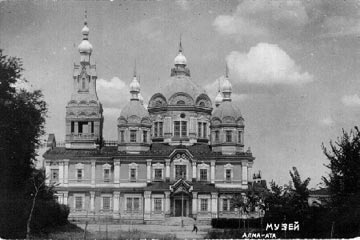
The Central State Museum of the Republic of Kazakhstan is one of the oldest and largest museums not only in Kazakhstan, but also the entire Central Asian region. The collections of the museum include about 300 thousand objects. Currently, the museum has five main stationary halls. Diverse collection provides a good picture of the paleontological past, of the ancient, medieval, modern and contemporary history and cultural tradition of Kazakhstan.
The creation of museum collections was initiated in the 30s of the 19th century in Orenburg, at Neplyuev Military School “Museum of the Orenburg region”. One of the organizers was a famous linguist, author of “Explanatory Dictionary” Vladimir Dal.
In different years the museum collection composed not only the museum collection of the Orenburg region (1924), but also the Zhetysu (Semirechye) Regional Museum (1929) and the National anti-religious museum (1941) which was placed in the building of the Voznesenski Cathedral in Alma-Ata city. This unique architectural complex was built in 1904-1907 and designed by the well-known Verny architect A.P.Zenkov.
In 1944 the museum was assigned to the 1st category and received its present name – the Central State Museum of Kazakhstan.
This building was constructed by architects Yu.Ratushnyi, Z.Mustafin and B.Rzagaliyev in 1985. It is considered one of the finest buildings of modern architecture of the Almaty city. The total area of the museum building is 17,557 square meters.
Among the exhibits there are unique masterpieces: gold articles which reflect cultural tradition of tribes of early nomads of Kazakhstan. Found during excavations in Zhalauly, Pokrovka, Kargaly villages, Shilikty kurgan; collection of Scythian-Saka bronze boilers and altars (connected with the cult of fire and ancestors, made in the tradition of the animal style of Saks), personal seal of S. Toraigyrov, certificate of merit signed by S. Altynsarin, manuscript of Turagul about the father of Abai, the first issue of “Aikap” magazine, rifle of Imanuly, personal complexes of Shokan Valihanov, Zhayu Musa, Amre Kashaubayev, Alibi Zhangildin, Saken Seifullin, Kulyash Baiseitova and others.
Great contribution to the formation of the museum’s collection made well-known figures of the Kazakh culture, literature and art, scientists, historians, politicians and public figures. Among them A.Baitursynov, A. Zhirenchin, G. Mustafin, K. Badyrov, A.Margulan and many others.
In recent years, with the support of partners of the museum have been implemented ambitious museum projects – exposition complexes: “Open fund. Archaeological gold of Kazakhstan”, “Museum of Anthropology”. For the first time in the museum practice of Kazakhstan have been implemented the projects on creation of a series of scientific reconstructions of costumes and accessories of ancient archetypes – “Andronovo woman of Bronze Age”; “Kangui woman 1st century BC – 4th century AD”; “Kipchak Warrior IX-XI”; “Huns Warrior 2nd – 3rd century AD”; “Hun warrior 5th– 3rd century BC”.
The heads of the Central State Museum – A.M.Zhirenchin (1942-1951), S.S.Esova (1956-1973), R.I.Kosmambetova (1974-1995), G.B.Dyusenbinova (1995-1997), E.T.Zhangeldin (1997-1999) made a feasible contribution to the development of the main museum of Kazakhstan. A number of historical and ethnographic expeditions to various regions of the republic were organized, as a result of which a huge number of materials were collected reflecting the life, traditions of the Kazakh people, art, political and social history of the life of the peoples of multinational Kazakhstan.
As world experience shows, it is the functioning of the museum, first of all, as a scientific structure, that allows it to implement its diverse educational functions at a higher level. In 2005, the Museum received the official status of a research organization, which served as a new impetus for the improvement of research (including collection) and cultural and educational work. The Central Museum, as an independent subject of research activities, actively participates in the implementation of numerous socially and scientifically significant research projects within the framework of the large-scale State Program “Cultural Heritage”. Based on the results of the research, over 30 publications were published, including scientific catalogs on archeology, ethnography, numismatics and narrative sources on the ancient and medieval history of Kazakhstan. All of them were highly praised by specialists and the scientific community not only in the republic, but also in scientific circles in a number of foreign countries (France, Italy, Germany, Russia, etc.).
Since 2008, in the museum launched its activity the Scientific Library, established on the initiative and with direct participation of Nursan Alimbay. During these years, was introduced the program “Museolog” e-cataloging and certification of fund collections, initiated by UNESCO, which is an innovation in museum practice of Central Asia.
For a long time, the Central State Museum of the Republic of Kazakhstan has performed and continues to perform the functions of the main institution in the museum space of the country, and the most valuable rare historical and cultural monuments of our people, which are a national treasure, are stored and exhibited in its rich collections. The Central State Museum is the most visited museum in the country, annually hosting up to 2
50 thousand people, organizing and holding over 200 lectures; annually creating over 50 exhibitions, holding popular events and various cultural and educational programs among the population.
On March 14, 2023, the first issue of the scientific and practical journal “MUSEUM.KZ” was published. The scientific and practical journal “MUSEUM.KZ” covers the latest scientific achievements in the field of museum work, and also popularizes the domestic and world cultural heritage. Improving the professional level of museum work, using museum exhibits as sources in studying the history and culture of our homeland are the main mission of this journal. Today, the Central Museum, considered the leading and largest museum in the country, has the following main areas of activity: cultural and educational, exhibition and display, scientific research, restoration, editorial and publishing, successfully operates in the field of information and other services, and carries out extensive work to implement the modern policy of our state in the field of culture and science.



